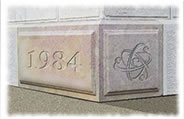Catching the Big Idea
(The continued flogging of last week’s concept…)
“Consciousness is like a flowing river. Ideas come floating by…
If you fail to catch one, it disappears from view…”
— J. R. St.John
Does a Document, a Speech, a Presentation, or a Project appear to you initially as a finished artifact, or as a series of components? Does it just materialize?
In our experience, nothing falls from the sky fully composed. That’s not how it’s done.
For most people, a small portion reveals itself, in pieces. A word, a phrase, a hint… You look at it, ponder, and perhaps a little more comes into view; then you have to spend some time digging, researching, conceptualizing, expanding, finishing and polishing in order to create a finished intellectual product.
And there’s no telling exactly how those little inspirations are going to arrive. Upside down? Sideways? Quickly in a rush? Leaping into awareness? Big Opening, then requiring continuous sculpting to get the rest in shape? Nobody knows, and the Big Ideas rarely come into view the same way twice. But then, they always come in pieces…
If you’ve got a net, you don’t worry about the order of appearance… So why not relax, and let it arrive any old way it wants? The whole process will go better if you have your net ready. Wait… a template.
The Template Traps the Ideas as they appear. It’s a “Net for Ideas.”
A “Ready, Set, Go!®” Box Diagram is a net for catching and arranging ideas into a repeatable format, which works equally well for designing and delivering Presentations, as it does for building Marketing Documents or Interactive Meeting Programs. They are all just ideas, captured, crafted and packaged for duplication and consumption.
Whether you catch an idea floating by or craft something from scratch in the recommended order, the material benefits from being delivered in a standard way so your audiences become relaxed about listening to you — confident that they don’t have to invent or suss out your unique delivery system. You tell them how it’s going to come along, then you present in just that order. Problem solved! And once it’s all out, you can summarize to help people “fix” the ideas in their minds to take away after the meeting.
A particularly smart client recently commented that he resented our barging into the sanctuary of his creative process with something as intrusive as a communication template! I responded by asking if he intended to create a new intellectual format for his upcoming 15 minutes with the group??? “Huh?” he said.
“Well,” I countered, “If you are going to create from scratch, you sort of have to first create the Love Letter format… Or the Sonnet, or the Haiku, or the Folk Format Love Song. Then of course, you must introduce your new form to the audience so they can comprehend what you are creating. Then you pour in your unique content to fill out your format… Right?”
He decided on a “Poetry Jam…” Fortunately, that format was already on the shelf — waiting for his ideas to come along.
When you’re fishing for the Big Idea, it’s good to have a Net handy.
Applications
1. For You
Maybe the simplest intellectual template is a Story. From Aristotle: “Everything in Life has a Beginning, Middle and End.” So it is with stories. If you can tell a story, you have a future at the campfire, the water cooler or the bar. And it all revolves around understanding that without an end, it just doesn’t work. Without a beginning, there’s no ramp up to the climax. Without a middle, there’s no gathering of tension or interest. You’ve got to have all three. So build your communication props by learning to tell stories. Read O’Henry to polish up your understanding.
2. At Home
The Spoken or Read Out Loud Report is a constant source of stress for the kids at school. There’s a standard format, without the exposed structural clarity of a presentation. If you want to ease the childhood “Rite of Passage” explain that there’s a standard way to build a report: Beginning, Outline, Detailed Individual Paragraphs, and Conclusion. Then “hold their hand” as they locate the information to fill in their Template. They’ll think you’re a genius.
3. At Work
A Presentation has a format, which is set up purposefully to make listening easy for the audience. Stick to the Template, and the audience will remember you’re the one that always makes sense. Give them a next step every time, and they may make you President.
With the right Net, you stand a better chance of catching the Big Idea!
Dessert:
Subscribe to our Newsletter


